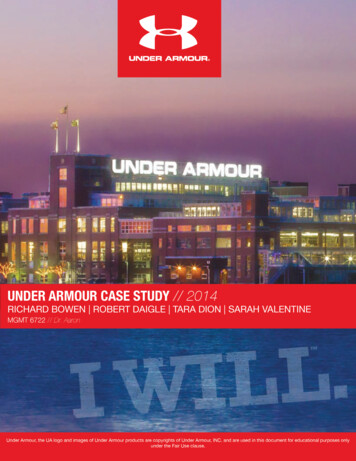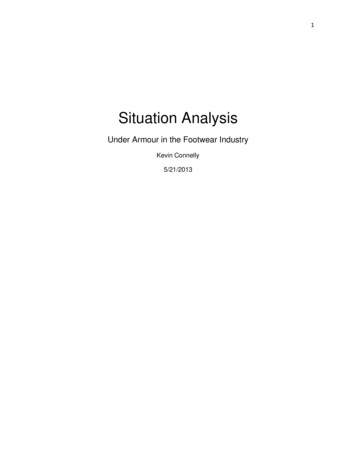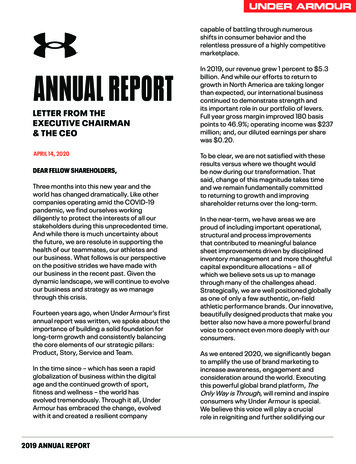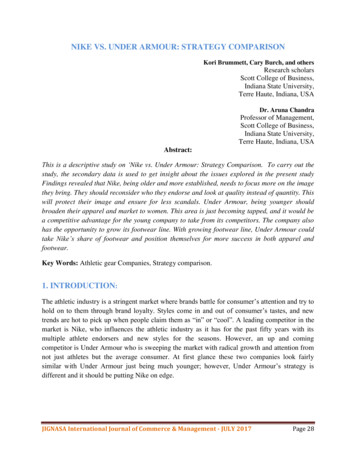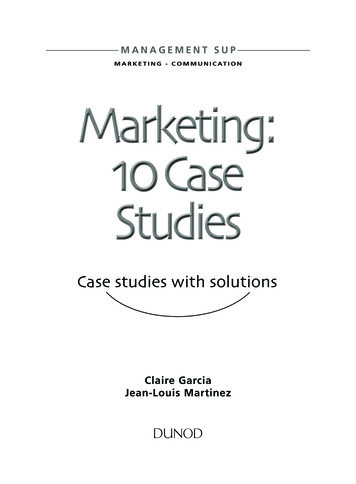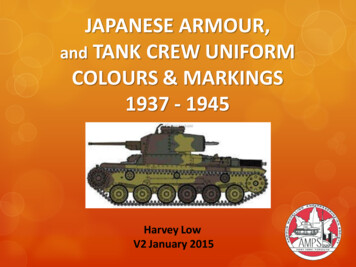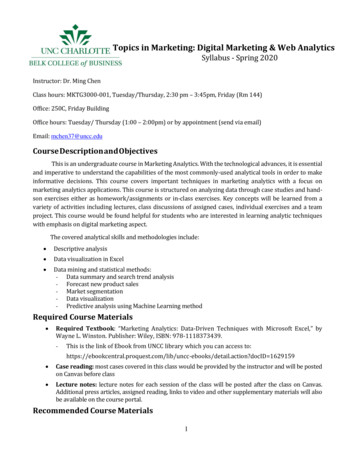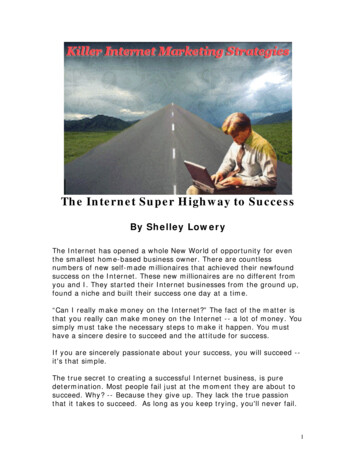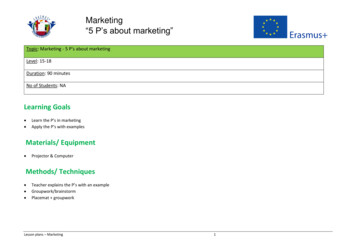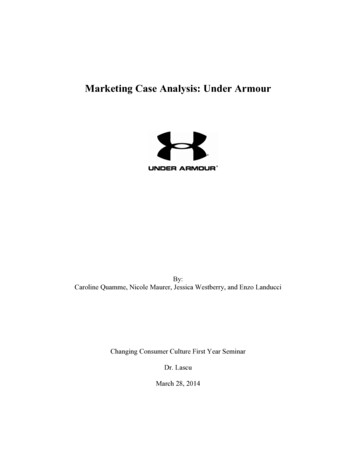
Transcription
Marketing Case Analysis: Under ArmourBy:Caroline Quamme, Nicole Maurer, Jessica Westberry, and Enzo LanducciChanging Consumer Culture First Year SeminarDr. LascuMarch 28, 2014
TableofContentsExecutiveSummary RelativetoCompetition.12ReferencedSources . 11AdvisingandReccomendationsforFuture 12
ExecutiveSummary“We are relentless in our pursuit to better leverage the Under Armour brand acrossbroader categories such as footwear and deeper into international markets” stated Under ArmourCEO Kevin A. Plank in a 2010 press release (Business Case Journal, 2012). Despite suchaspirations at the turn of the decade, Under Armour has yet to fully penetrate the footwearmarket successfully. Since the company’s founding in 1996, Under Armour has established areputation within the athletic sportswear and equipment fields, particularly specializing in theproduction of synthetic moisture wicking fabrics and compression shorts (Business Case Journal,2012). When footwear merchandise did not sell as well as apparel, Under Armour was facedwith the challenge of mediating the balance of profitability from all of its product sectors.With the profitability of Nike and Adidas, Under Armour has continuously struggled tocompete in the footwear market. These companies are the top two producers of athletic footwearyear after year, collectively controlling over 63% of the market (Van Riper, 2013). If UnderArmour fails to seamlessly add footwear to their collections, they will overtime completelydisappear from the market and loss relevance. Additionally, other brands are providing cheaperalternatives to apparel and footwear that appeal to consumers during times of economic hardship,further hindering Under Armour’s sales. By assessing the threats and opportunities in theenvironment in which the company exists and understanding the strengths and weaknesses oftheir business strategies, Under Armour can move towards establishing themselves equallyacross all realms of their merchandise. Following these assessments, the company can segmentthe market into groups according to common needs and uses of products, therefore facilitatingthe positioning and targeting of merchandise to yield higher profits.
MacroeconomicEnvironmentUnder Armour has dominated the performance apparel industry since its inception, as itwas the first company to specialize in high quality clothing tailored towards athletes.Throughout the company’s history it has continued its dedication to innovative technology, andhas expanded to include clothing for nearly all sports and weather conditions.Recently, the social pressure to create green products has led Under Armour to create anew initiative called “Under Armour Green” (Under Armour, 2013). Under Armour’s newfounddedication to being an environmentally conscious company stems from the social and politicalpressures for companies to produce products with the smallest possible environmental footprint.By adhering to higher environmental standards, Under Armour will be able to attract more ecoconscious consumers.Under Armour is a leader in the performance apparel industry, but has been unable toexpand its success into the international and footwear industries. Under Armour has not yetsuccessfully broken into international markets, and is looking for new ways to market theirproducts around the world. Currently, Nike and Adidas are dominating the market for athleticfootwear, leaving little room for Under Armour (Van Riper, 2013). Nike and Adidas are UnderArmour’s main competitors, and act as its main threat. If Under Armour is unable to break intothe international and footwear markets, it will no longer be able to compete with its competitors.Additionally, the United States’ economy has been hurting Under Armour’s salesthroughout the last few years. In 2009, “Under Armour’s sales growth dipped below 20 percent[because of] the Great Recession [that] whacked the economy (Yahoo Finance, 2013).Furthermore, the high wages in the US have forced Under Armour to outsource itsmanufacturing (Business Case Journal, 2012). Many of Under Armour’s factories are located inAsia and Latin America. All apparel, footwear, and accessories are designed in the US, but the
company is unable to manufacture its products in the US for a reasonable price. In addition tothe struggling economy, Under Armour’s low footwear sales have hurt its stock price. Thedecline in the stock price led the company suspend the planned expansion of its footwear line.MicroeconomicEnvironmentThe Under Armour brand is a strong presence in the sportswear market in the UnitedStates. Under Armour currently holds the largest market share in performance apparel, and wasa pioneer in the industry (Business Case Journal, 2012). Under Armour strives to be a leader inthe international market, and is focused on improving its footwear sales both domestically andinternationally. Under Armour’s research and development team focuses nearly entirely on howto grow Under Armour’s presence in the athletic footwear industry. Under Armour targets men,women, and children from middle class and upper class backgrounds. A typical Under Armourcustomer is athletic and health conscious. The company’s high quality lines of performanceapparel, athletic footwear, and sporting accessories appeal to a wide range of demographics.Under Armour sells its apparel, footwear, and accessories at a competitive pricecompared to its competitors. For example, a pair of Under Armour men’s football cleats wouldcost a consumer 119.99 (Business Case Journal, 2012). Nike cleats, however, would cost 129.99 and Adidas cleats 99.99 (Business Case Journal, 2012). Typical Under Armour pricingplaces in in-between Nike and Adidas, but unlike its competitors, Under Armour rarely discountsits items and tends to be sold at a slightly higher price. Under Armour’s products are sold ontheir website as well as in large department stores such as Sears, and in sporting goods storessuch as The Sports Authority. Under Armour footwear can also be found at Finish Line and FootLocker.
Under Armour relies on print, digital, and television advertisements in addition tosponsored college athletic teams and professional athletes to promote the Under Armour brand.Under Armour’s advertisements are typically aimed at athletic males, but incorporate youthfriendly images as well. Under Armour models are often portrayed in skintight clothing, givingthem the illusion of being a superhero. Furthermore, the company’s youngest customers idolizemany of the sponsored professional athletes, establishing their permanent interest in the brand.Finally, Under Armour has recently developed a new marketing campaigned aimed at women,which promotes active lifestyles and a healthy body image among the average young femaleconsumer.
SWOTAnalysisStrengths Pioneer in the industryAdvanced technologyAppeals to multiple demographicsStructure their ad campaigns to targetspecific market segmentsCompetitive pricingLargest market share in performanceapparelDuopoly with NikeVisible brandOpportunities Lots of room for international growth Working to improve footwear sales Growing market segment of young,athletic women Create pricing tiers Expand beyond sports Emphasize other sportsWeaknesses Low shoe sales Not a major player in the internationalmarket No discounted pricing Most advertisements are targeted at men Narrow range of productsThreats Nike and Adidas dominate the footwearindustry US Economy is suffering Champion is gaining power in theindustry Less expensive substitutes in the market
SegmentationandSegmentationPieGraphsAge0-10 years10-18 years18-30 years30 years and overUnder Armour’s first major market segmentation group is the age of their customers.Different aged people demand different products and Under Armour has produced certainmerchandise to appeal to each category. The age group of 0-10 only consumes 10% of thecompany’s goods because of their young age and rare participation in athletics that would requirethe apparel. Under Armour caters to this niche by producing colorful and fun printed goods at alower price, sports equipment for beginners, and creating an image through commercials andadvertisements that children of this age group aspire to be. For the second age group of 10-18years, the company sponsors sports camps in order to promote their products that correlate to thissegment such as sports equipment and recreational clothing and also begin pricing their itemsparallel to the quality at this segment. In the 18-30 age segment, college athletes and activeyoung adults are included who consume high quality athletic apparel and accessories regularly tosupport a healthy lifestyle. To appeal to this group, Under Armour sponsors collegiate teams andsell their products at competitive prices at college bookstores and athletic apparel stores that areaccessible to this group. Finally, individuals over the age of 30 do not require as specializedsegmentation as the other age groups. People of these ages are already active, brand loyal, and
willing to pay for Under Armour product, allowing the company to forego heavy advertisingexpenses towards this category.GenderMaleFemaleAfter segmenting consumers according to age, Under Armour then divides the market bygender. In our opinion, both females and males respectively make up roughly 50% of the market.For females, the company produces apparel in fun colors that are considered fashion forward andpricing these garments in alignment with other fashionable athletic wear. In addition, womentend to wear athletic apparel more casually than men, so Under Armour produces yoga pants andother clothes that can be worn actively and for everyday purposes. In order for these items toappeal towards women, Under Armour has launched a “Power in Pink” campaign to promotetheir products and support breast cancer survivors (Under Armour, 2013). For men, the companyhad established its brand differently to appeal towards this group. Products catered towards menhave a more masculine vibe – tight fitting, durable, and resistant to wear-and-tear. They havealso produced cleats and specialty footwear to further establish the brand as a well-rounded andreliable athletic company. To promote this merchandise, Under Armour uses very toned and
12muscular models, including mannequins that provide a visual for what consumers can aspire e next step of Under Armour’s market segmentation includes the range of uses thatconsumers have for the products. One of the ways in which Under Armour has acquired nationalrecognition is through its sponsorship of professional athletes such as Tom Brady and LindseyVonn (Wagner, 2013). Although there is no price on these products, Under Armour is able topromote their products towards other segments of the market, including fans of the athletessponsored. Similarly, Under Armour endorses collegiate teams such as the Auburn UniversityTigers and University of Notre Dame Fighting Irish (Under Armour, 2013). By putting its nameand emblem on uniforms and gear, the company is able to promote its brand and products. Thecollegiate use is a smaller portion of the market compared to professional use because consumerstypically follow professional athletes more than collegiate athletes therefore Under Armourallocates its resources accordingly. The largest use of the company’s products, whether apparel,footwear or accessories, is the recreational segment of the market. Recreational use includes allindividuals who participate in mild to rigorous athletic activity on a consistent and regular basis.Almost all of Under Armour’s moisture wicking and specialty products are targeted to this use
and the company uses the recognition from the professional and collegiate promotions to appealto this sector. The remaining uses of Under Armour products are allotted to casual, everydaywear. These products are created to be more comfortable and versatile, and priced slightly lowerto reflect the absence of high quality and specialized athletic material in the goods. A majority ofthese unspecialized products are promoted through Under Armour’s website and in stores, whoconvince consumers to try these goods.ClimateHotColdThe final segment that Under Armour considers is the climate that the products areutilized in. The company’s product lines are devoted to regulating body temperature in either hotor cold climates. Under Armour originally designed a moisture wicking fabric known “HeatGear”that worked to regulate sweat and body temperature when active in hot climates (CASE).Because of this technology, the price for these products using these materials is higher incomparison to competitors but still popular because of their established reputation. Following thesuccess of the “HeatGear” line of apparel, Under Armour worked to create a line that had asimilar function but in colder and more severe climates. These products are pro
successfully broken into international markets, and is looking for new ways to market their products around the world. Currently, Nike and Adidas are dominating the market for athletic footwear, leaving little room for Under Armour (Van Riper, 2013). Nike and Adidas are Under Armour’s main competitors, and act as its main threat. If Under Armour is unable to break intoFile Size: 672KBPage Count: 16
